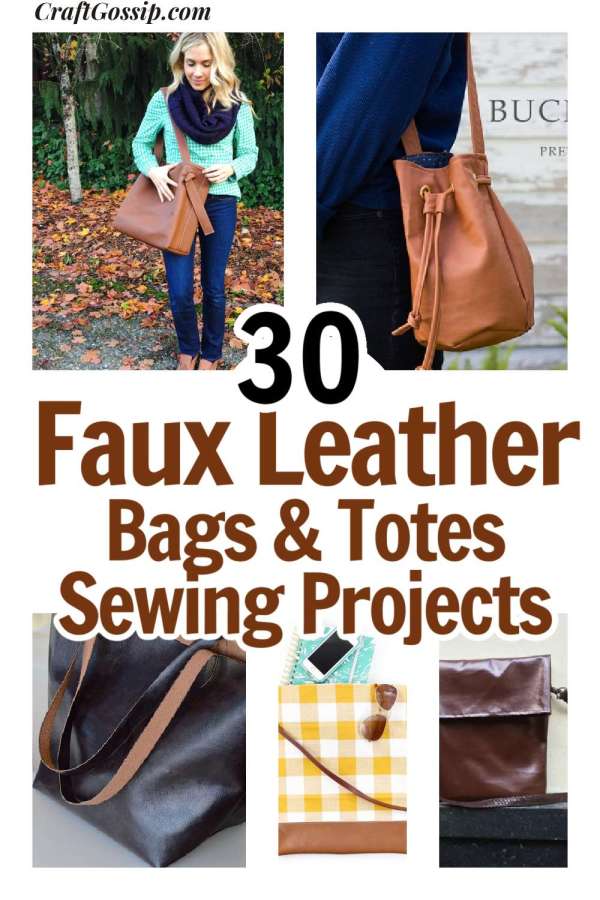Toted as “the Dressmaker’s Resource” Pattern-Making.com is a great resource for the avid sewer. Although it does have lots of knitting and crochet patterns, it also has some great sewing and pattern making info. I was inpressed with the tutorial for drafting your own bra pattern as well as the simple instructions on how to pivot a dart. And if you ever wanted to delve into the world of pattern grading, they have some great beginner tips.
Comments
Have you read?
30 Faux Leather Handbags You Can Sew: Stylish DIY Patterns for Every Occasion

There’s something undeniably chic about faux leather handbags. They add a touch of edginess and sophistication to any outfit, all while being more affordable and animal-friendly than their genuine leather counterparts.
If you’ve ever admired a friend’s stylish brown faux leather bag and wished you could find one just like it, you’re in luck! Today, I’m excited to share 30 fabulous faux leather handbag patterns that you can sew yourself. Whether you’re a seasoned sewist or a beginner looking to dive into bag-making, there’s a pattern here for you.
Tutorial: Faux leather tote with grommets – Sewing
Nautical Foldover Clutch — CraftBits.com
DIY Stylish Leather School Satchel — CraftBits.com
Make a Simple Leather Clutch — CraftBits.com
Faux Leather Drawstring Backpack TUTORIAL
DIY Faux Leather Bucket Bag | Pretty Prudent
Trendy Faux Leather Handbag – Sew4Home
Smart and Simple Tablet Cover Tutorial
Sew It – A Fall Plaid Crossbody Bag – A Kailo Chic Life
When working with faux leather, selecting the appropriate scissors is crucial to achieve clean cuts and maintain the material’s integrity. Additionally, understanding the distinctions between faux leather, vegan leather, and pleather can inform your material choices and project outcomes. These are my personal choice and are a the Best Scissors for Cutting Faux Leather . You really need a scissor that is sharp and fine.
Cutting faux leather requires tools that can handle its thickness and density without causing damage.
DIY Leather Strap Clutch Tutorial + Giveaway
Four Step Leather Tote TUTORIAL + Free Pattern
Business Card Holder – Professor Pincushion
A Tote Bag Pattern You Will Love! – Boxwood Ave.
DIY Posy Garden Leather and Fabric Tote
Video: Easy Leather Hobo Bag – Sew Sweetness
Gold Leather Kitty Purse DIY with the Cricut Maker – see kate sew
DIY Faux Leather Bi-color Tote Bag – Sewing Tutorial | Salty*mom
Small Faux Leather Purse free sewing pattern
Men’s Faux Leather Messenger Bag | Sewing Pattern With Video
Understanding Faux Leather, Vegan Leather, and Pleather
The terms “faux leather,” “vegan leather,” and “pleather” are often used interchangeably, but they have distinct meanings:
Faux Leather: Also known as synthetic leather, faux leather is designed to mimic the appearance and texture of real leather. It’s typically made from petroleum-based plastics like polyvinyl chloride (PVC) or polyurethane (PU), applied to a fabric backing.
Vegan Leather: This term refers to materials that replicate the look and feel of real leather without using animal products. Vegan leathers can be made from various materials, including plant-based sources like pineapple leaves, mushrooms, and apple peels, as well as synthetic materials like PVC and PU.
Pleather: Short for “plastic leather,” pleather is a colloquial term for faux leather made primarily from PVC. It’s often used to describe lower-cost synthetic leather alternatives.
While all these materials aim to provide alternatives to genuine leather, their compositions and environmental impacts can vary. Faux leather and pleather are typically made from synthetic polymers, whereas vegan leather can encompass both synthetic and plant-based materials. It’s important to consider the source and sustainability of these materials when making your selection for projects.
By choosing the right scissors and understanding the nuances between these materials, you can enhance your crafting experience and make informed decisions for your projects.
What I really want to know is how do I enlarge a small sized pattern to my size(20). I found lots of very beauty dress and pantsuits patterns from the 1950s and the 1960s and I want to be able to look at the outfit on the front and back of the pattern and sew by sight or learn how to create a pattern just by looking at the pattern. Can you please help!!!!!!
Deborah
PS I will begin sewing lessons very soon.
Deborah,
I wish I could give you some info on grading patterns, but that’s one of the skills that I’m also wanting to learn. And for exactly the same reasons – I have a collection of fabulous patterns from the 50s to the 70s that are all in the wrong size!!
–Anne